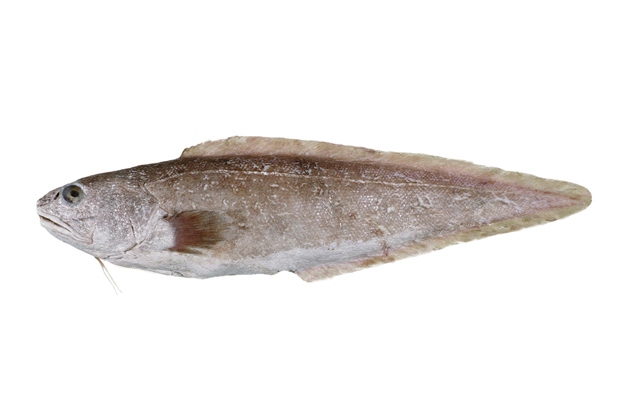Tusk, Dannevigia tusca Whitley 1941
Other Names: Australian Tusk, Tuskfish

Tusk, Dannevigia tusca. Source: Australian National Fish Collection, CSIRO. License: CC by Attribution-NonCommercial-ShareAlike
Summary:
A robust pale brownish to creamish cusk eel, with four rather diffuse broad brown bands along the sides and fins, a black lining to the gill chambers and abdominal cavity, and the outer edges of dorsal and anal fins have darker outer margins. Large individuals are uniformly brown.
Cite this page as:
Bray, D.J. 2023, Dannevigia tusca in Fishes of Australia, accessed 28 Jun 2025, https://fishesofaustralia.net.au/home/species/4580
Tusk, Dannevigia tusca Whitley 1941
More Info
|
Distribution |
Bass Strait, Victoria, and western Tasmania, to west of Bunbury, Western Australia. Inhabits the deep continental shelf and upper slope. |
|
Features |
Dorsal fin 96-103; Anal fin 76-80; Pectoral fin 24-27; Pelvic fin 2; Caudal fin 8; Lateral line scales 100. Body moderately elongate, shallow (19-22% SL), slightly compressed, tapering to point posteriorly. Head moderately small (19-25% SL); eyes moderately small (15-24% HL); mouth large (upper jaw length 50-57% HL), terminal, angled obliquely, maxilla reaching just beyond posterior margin of orbit; band of fine teeth in each jaw, prominent bands of teeth on vomer and palatines; operculum with prominent spine dorsally and smaller spine ventrally; anterior nostril not tubular, located about midway between lip and posterior nostril; opercular membranes free from isthmus. Scales very small, cycloid, covering all of head; lateral line arising at upper end of gill opening, parallel to dorsal profile of side. Dorsal and anal fins confluent with pointed caudal fin, having extremely long bases and rather uniform height; dorsal fin arising above pectoral-fin base. Pectoral fins prominent, reaching about three-fourths way to anus. Pelvic fins elongate, arising below posterior rim of eye, reaching halfway to anus in small individuals. |
|
Fisheries |
Taken and retained as a minor bycatch in bottom trawl fisheries. |
|
Etymology |
The specific name is a Latinization of the common name, Australian Tusk. The type specimen was collected by Dannevig, who named it in reference to the similarity he saw between this specimen and the European Tusk, Brosme brosme. |
|
Species Citation |
Dannevigia tusca Whitley 1941, Australian Zoologist 10(1): 42, pl. 1(28). Type locality: edge of bank southwest off Eucla, Western Australia, 80-120 fathoms. |
|
Author |
Bray, D.J. 2023 |
|
Resources |
Tusk, Dannevigia tusca Whitley 1941
References
Cohen, D.M. & Nielsen, J.G. 1978. Guide to the identification of genera of the fish order Ophidiiformes with a tentative classification of the order. National Marine Fisheries Service (U.S.). Technical Report 417: 1-72 figs 1-103
Gomon, M.F. 1994. Families Ophidiidae, Bythitidae, Carapidae. pp. 365-375 figs 326-335 in Gomon, M.F., Glover, C.J.M. & Kuiter, R.H. (eds). The Fishes of Australia's South Coast. Adelaide : State Printer 992 pp. 810 figs.
Gomon, M.F. 2008. Family Ophidiidae. pp. 352-355 in Gomon, M.F., Bray, D.J. & Kuiter, R.H. (eds). Fishes of Australia's Southern Coast. Sydney : Reed New Holland 928 pp.
Hutchins, J.B. & Swainston, R. 1986. Sea Fishes of Southern Australia. Complete field guide for anglers and divers. Perth : Swainston Publishing 180 pp.
May, J.L. & Maxwell, J.G.H. 1986. Field Guide to Trawl Fish from Temperate Waters of Australia. Hobart : CSIRO Division of Marine Research 492 pp.
Nielsen, J.G., Cohen, D.M., Markle, D.F. & Robins, C.R. 1999. Ophidiiform Fishes of the World. An annotated and illustrated catalogue of pearlfishes, cusk-eels, brotulas and other ophidiiform species known to date. FAO Fisheries Synopsis No. 125 Vol. 18. 178 pp.
Uiblein, F., Williams, A., Sithole, Y., Everett, B. & Matiku, P. 2020. Dannevigia tusca. The IUCN Red List of Threatened Species 2020: e.T137475316A137489866. https://dx.doi.org/10.2305/IUCN.UK.2020-1.RLTS.T137475316A137489866.en. Accessed on 01 November 2022.
Whitley, G.P. 1941. Ichthyological notes and illustrations. The Australian Zoologist 10(1): 1-50 figs 1-32 pls 1-2 See ref at BHL
Williams, A., Althaus, F., Pogonoski, J., D. Osterhage, D., et al. 2018 Composition, diversity and biogeographic affinities of the deep-sea (200–3000 m) fish assemblage in the Great Australian Bight, Australia. Deep-Sea Research II 157-168: 92-105.
Yearsley, G.K., Last, P.R. & Ward, R.D. (eds) 1999. Australian Seafood Handbook. Hobart : CSIRO Marine Research 460 pp.


